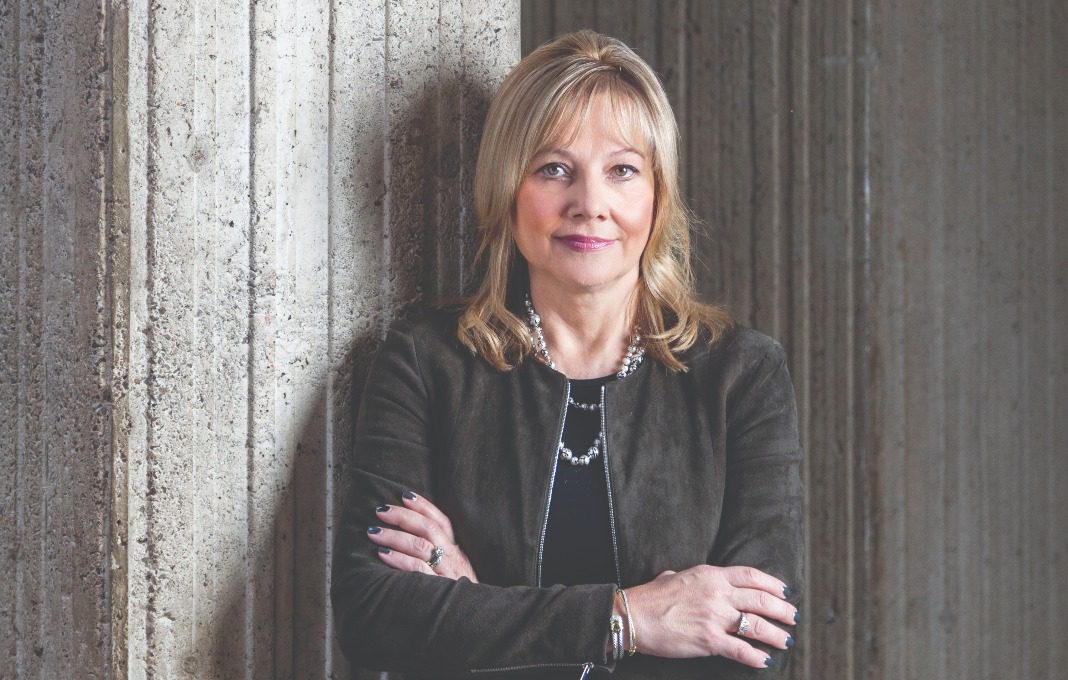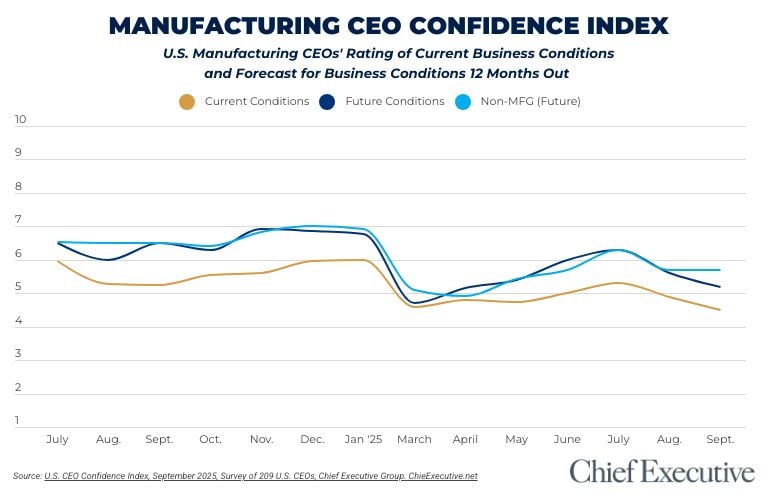


Last spring, Mary Barra created another stir in the auto business, this time by changing the top board title at General Motors—which she holds—from “chairman” to “chair.” Ford soon followed similarly, and Barra got huzzahs from diversity mavens around the world.
But the title change was far from merely symbolic. It also was highly reflective of how GM’s leader has hitched gender recognition to a remarkable new heyday for America’s largest automaker. Barra shattered a thick glass ceiling when she rose to CEO of GM seven years ago, becoming the industry’s first female head. Since then, as chair, she has put together one of the few majority-women boards in the Fortune 500—and, certainly, one of the most important. GM is among only 5 percent of companies in the Russell 3000 index at which women account for at least half the directors.
“It’s something I personally feel strongly about, and [diversity is] something General Motors counts among its company values,” Barra tells Corporate Board Member. “It has long been a top priority of the board and the governance committee to ensure that GM has a board composed of directors who bring diverse viewpoints, possess a variety of skills, professional experience and backgrounds, and effectively represent the long-term interests of shareholders.”
She notes that GM was the first Fortune 500 company to seat an African-American director, Rev. Leon Sullivan, in 1971. GM elected its first woman director, Catherine Cleary, in 1972, whereas Ford’s first female director wasn’t elected until 1976. When Alexandra Ford English joined Ford’s board in May, she became the first female member of the founding family to sit as a director in the company’s 118-year history.
Barra says “the fact that some of [GM’s directors] happen to be women was a bonus, not a dictate.” But Tim Solso calls the fact more intentional. “I think it’s a great accomplishment to have a female-majority board,” says the former CEO of engine maker Cummins, who left the GM board as lead director early this year after a nine-year stint on the board. “It makes a statement about the company and how progressive it is. And it’s one of the best boards I’ve ever seen in terms of how it functions and how it is involved in helping the company become what it can become.”
Traditionally, industrial CEOs and CFOs steered GM’s board along with insiders—nearly all white males. But a board with seven females out of 13 is how Barra is addressing a future for GM aimed at dominating in electric and automated vehicles and being the industry standard bearer for leadership diversity.

Patricia Russo, GM’s lead director, says the company’s evolved board is ready for the challenge. For example, Jami Miscik, CEO and vice chair of a consulting firm founded by former Secretary of State Henry Kissinger, joined the GM board in 2018 and “really understands geopolitical issues and risks around the world,” says Russo, who is chairman of Hewlett Packard Enterprise. A director since 2015, Linda Gooden “understands the criticality of safety and quality” after serving as executive vice president of information systems for Lockheed Martin. And the newest female director, Meg Whitman, former CEO of Hewlett-Packard and eBay and candidate for governor of California, “brings an incredible breadth of experience in the startups and venture world.”
Barra is continuing to lead a corporate transformation at the board level that she launched after emerging from the ranks of upper management in 2014 to take over a company just beginning to find its way out of bankruptcy and the Great Recession. She rumbled through GM’s ignition-switch debacle, sold its long-held European operations, closed some U.S. plants, deep-sixed many sedans, invested heavily in digital-tech startups, committed the company to make its own electric-car batteries, and then promised to spend $35 billion to convert GM’s fleet nearly completely to EVs and automated vehicles by 2035.
Along the way, Barra has dazzled industry veterans with her performance as CEO—and with her approach to the job. “She’s inherently a team person and a very effective communicator across the various verticals of the business,” says David Cole, chairman emeritus of the Center for Automotive Research in Ann Arbor, Michigan, who has observed and consorted with many automotive CEOs over the decades. Barra contrasts with past chiefs who “were sort of king leaders,” such as Roger Smith, GM’s chairman and CEO through the 1980s. “It was all about him,” Cole says, “and not much about the team.”
Still, it is possible to look at all Barra has accomplished as CEO and conclude there is much unfinished business, including in the area of gender engagement. U.S. automakers and their dealers have progressed light years from the days when women were considered mere auxiliaries to the auto-purchase process. Companies aim brands and vehicle personae at female sensibilities now, recognizing not only that women buy many vehicles on their own but also that their opinions score heavily in the majority of purchases. So, women today are the marketing chiefs at GM, Ford and the U.S. operations of Stellantis, Hyundai, Toyota and more.
That’s why, of all the changes Barra has made, GM’s board makeup may be among the most important. “Boards talk all the time about having people sitting around the table who reflect the customer base, especially if it’s a consumer-oriented company,” Russo says. “And women in a company like to look up to a board that is heavily populated with women who look like them. Talking the talk is very important for recruiting.”
GM’s governance makeover began 12 years ago, after its bankruptcy and bailout, when the governments of the United States and Canada dictated a new board.
Carol Stephenson was the Canadian appointee. “It was a pretty unnatural situation to take 13 of us, and—boom—you’re a board,” says Stephenson, former dean of the business school at the University of Western Ontario, with stints on a dozen corporate boards. “We didn’t have a lot of experience in the industry. No one knew each other. We were on a huge learning curve, and survival was top of mind. And when we were recruiting board members, we didn’t know the culture or what we were trying to accomplish.”
Solso says the GM board “was dysfunctional. We didn’t force people out, but people retired, and when they retired, there was the opportunity to implement” a new approach. As GM climbed out of the chasm and an industry recovery took hold in the early 2010s, its board pivoted to the future.
The board elected Solso non-executive chair in 2014 and selected him and Barra to join Russo, Stephenson and James Mulva, former chairman and CEO of ConocoPhillips, on the governance and social responsibility committee. They formed a vision of a fresh board that could best leverage GM’s renewed prosperity into an even brighter future.
“We needed people who’d been through challenging times and understood what it takes for a large company like GM to make changes that need to be made and become more agile and efficient and externally focused,” Russo says. “At the time we were looking for a combination of skills: people who’d led large, complex, global companies; people with financial expertise. We were looking for technology expertise, as we had a lot of work to do with respect to information systems. We wanted people who’d had some consumer-marketing experience, too.”
At the same time, the committee began guiding board succession in an additional direction. “Our goal was first and foremost to have the best board we could possibly have, and that meant we needed to have as diverse a board as we possibly could,” Solso says.
Soon after they elected Barra chair in 2016, the board wrote a strategic plan for how its makeup should further evolve to reflect the challenges and opportunities ahead for GM. “It was clear the company was going through a fundamental transformation,” Russo says, “so we laid out a five-year view of what directors would be leaving and what skill sets we believed we needed, and that has really informed a lot of the additions we’ve made to the board over time.”
The board hired Heidrick & Struggles, the New York–based executive-search giant, landing on Bonnie Gwin, co-managing partner of its global board practice, to be GM’s sole recruiter of new directors. They’ve stuck with her, which is an unusual practice, board members and governance experts say.
“We found [Gwin] a good adviser who understood our needs and our set of values, not just the skills we were looking for but also character and other things that needed to go along with them,” Stephenson says. “She came up with great candidates for us who turned out to be great board members, so we’ve continued to use her.”
Gwin declines to comment specifically on her work for GM. But she describes the Heidrick & Struggles approach as “putting together a skills matrix and a strategy for 10 years. What are the experiences that will be helpful and important? What boxes do current directors check, and what are the gaps?” Gwin says a board should “hold a search firm accountable for a diverse plate and consider itself accountable for considering women as part of the slate. Everyone needs to own it.”
The committee considers “a skills and qualifications matrix for current directors and any additional characteristics that it believes one or more directors should possess based on an assessment of the needs of the board at that time,” Barra explains. “In every case, director candidates must be able to contribute significantly to the discussion and decision-making on the broad array of complex issues facing GM.”
To fill an opening, the governance committee has worked with Gwin to generate a list of as many as 15 candidates, insisting on diversity in the pool as a main criterion. The committee and Gwin select two or three finalists and interview them.
At the same time, Barra says, while GM “does not have a formal policy governing diversity among directors, our board strives to identify candidates with diverse backgrounds and experiences.” She believes “they can make us a better company in ways that transcend even the specific expertise and experiences they bring with them.”
Solso sees it similarly. “It wasn’t necessarily a goal that we wanted to have a female-majority board,” he says. “But we wanted people with different backgrounds and perspectives who would ask the right kinds of questions. The consequence of the process was that we have a female-majority board.”
Stephenson also concurs. “I never remember a discussion where we said, ‘We must have five female board members,’” she says. “But we said, ‘We can find really talented, skilled, qualified women, so let’s do that.’ And one day we woke up and said, ‘Our board is half women.’”
Now that she’s shaped a board that happens to have more members of her gender than males, how does Barra work with them? It’s a special point for Stephenson because in Canadian corporate governance, the CEO and board chair roles typically are kept separate. “So, I was a little skeptical,” Stephenson says. But Barra “works beautifully.” The chair “is a great listener. She doesn’t feel like she has to come in and have all the answers.” Russo calls Barra “transparent and authentic.”
Barra’s reputation for strong and effective collaboration was one of the things that got her the CEO job, and fellow directors say she has taken that practice to a new level with them. For example, Barra phones and conducts Zoom meetings with individual directors who have particular expertise.
“She genuinely wants to know what people think,” Solso says. “More than any other executive I’ve worked with, she wants input from the board and asks the board to comment on strategic issues, and she takes that input and responds to it. She may not agree with it, but she responds to it. Some execs go through a routine process, but Mary does a deeper dive, and as a result, board members feel they can add value and contribute.”
Even with all of this, some critics say Barra’s scorecard on diversity isn’t perfect. Early this year, executives of Black-owned media targeted the automaker in full-page newspaper ads for not spending enough advertising dollars in their channels, going so far as to call Barra a racist. They included Byron Allen, a former comic who’s now a media mogul as chairman and CEO of Allen Media Group, which owns the Weather Channel and provides video to broadcast and mobile devices.
GM hosted what Barra calls “a productive summit” with representatives of 200 such companies, resulting in the automaker’s commitment to boost advertising via the complainant group. “Among many actions, we will increase our spending with diverse media, which will drive economic empowerment and a sustainable ecosystem,” she says.
Regardless of how Barra handled the episode, Russo says, the charge was spurious. “The last thing anybody could call Mary is not inclusive or insensitive,” she says, adding that the board “has never questioned Mary’s commitment to inclusion and diversity in all aspects of how she runs the business.”
In the wake of George Floyd’s murder in 2020, for instance, Barra created an inclusion advisory board and has reiterated her goal of making GM the most inclusive company in the world. For good measure, GM’s latest board appointments included Mark Tatum, deputy commissioner and chief operating officer of the National Basketball Association, who is Black.
Ultimately, however, Barra acknowledges that even with a new cast founded on diversity, GM’s directors have a huge task ahead. “What we have done with the board has been widely recognized and well received,” Barra says. But, she adds, “The board would like to receive credit not for what it is but for what it does. And that, I’m confident, will come in due time.”




Chief Executive Group exists to improve the performance of U.S. CEOs, senior executives and public-company directors, helping you grow your companies, build your communities and strengthen society. Learn more at chiefexecutivegroup.com.
0

1:00 - 5:00 pm
Over 70% of Executives Surveyed Agree: Many Strategic Planning Efforts Lack Systematic Approach Tips for Enhancing Your Strategic Planning Process
Executives expressed frustration with their current strategic planning process. Issues include:
Steve Rutan and Denise Harrison have put together an afternoon workshop that will provide the tools you need to address these concerns. They have worked with hundreds of executives to develop a systematic approach that will enable your team to make better decisions during strategic planning. Steve and Denise will walk you through exercises for prioritizing your lists and steps that will reset and reinvigorate your process. This will be a hands-on workshop that will enable you to think about your business as you use the tools that are being presented. If you are ready for a Strategic Planning tune-up, select this workshop in your registration form. The additional fee of $695 will be added to your total.

2:00 - 5:00 pm
Female leaders face the same issues all leaders do, but they often face additional challenges too. In this peer session, we will facilitate a discussion of best practices and how to overcome common barriers to help women leaders be more effective within and outside their organizations.
Limited space available.

10:30 - 5:00 pm
General’s Retreat at Hermitage Golf Course
Sponsored by UBS
General’s Retreat, built in 1986 with architect Gary Roger Baird, has been voted the “Best Golf Course in Nashville” and is a “must play” when visiting the Nashville, Tennessee area. With the beautiful setting along the Cumberland River, golfers of all capabilities will thoroughly enjoy the golf, scenery and hospitality.
The golf outing fee includes transportation to and from the hotel, greens/cart fees, use of practice facilities, and boxed lunch. The bus will leave the hotel at 10:30 am for a noon shotgun start and return to the hotel after the cocktail reception following the completion of the round.